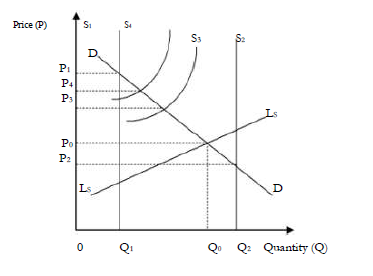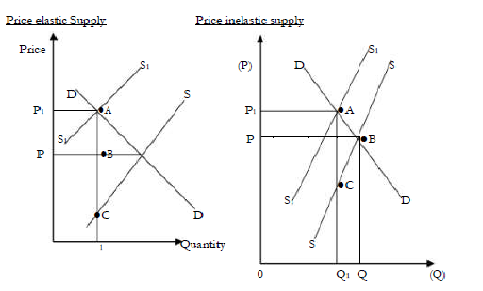1. Fluctuation of agricultural product prices:
Agricultural products/commodities tend to be supply inelastic (especially in the SR) because
production cannot be increased once a crop has been planted and most (of such commodities)
are perishable. Inelastic supply tends to cause more fluctuation in prices than elastic supply.

From the above diagram, the quantity expected to be supplied by farmers in the Long run (LR) is
shown by the supply curve LS which intersects with the demand curve to establish an equilibrium
price PO and the quantity QO. Suppose the actual supply is (finally) less at Q1 (due to unfavorable
weather etc) the prices will fluctuate highly to P1 from P0. If however supply increases to Q2 prices
will fluctuate from P0 to P2. If the commodity being supplied is more inelastic shown by the supply
curve S4 price will fluctuate less to P4. Moreover, if the supply is relatively more price elastic as shown
by the supply curve S3, price will fluctuate even lesser from PO to P3 etc.
Thus, elasticity of supply is relevant in explaining fluctuation of prices of agricultural products and seeking to
establish appropriate government intervention policies with a view to price stability.
2. Transfer/shifting or sharing of the tax burden/money – valuable tax:

A tax imposed will lead to a fall in supply represented by a leftward shifting of the supply curve.
From the diagrams above, the unit tax is AC
AB represents that portion of the tax which is paid by consumers while BC represents that portion which
is paid by producers.
In the case of a price elastic supply curve, AB is greater than BC. In the case of a price inelastic supply
curve, AB is less than BC. Thus the shifting of tax (transfer of money valuable tax) to consumers is more
effective in the case of price elastic than inelastic supply.
3. Export promotion by devaluation:
Elasticity of supply assists the government in determining the impact of devaluation on export
volumes and revenue in terms of foreign exchange.
Devaluation being the reduction of the value of a domestic currency relative to a foreign or
foreign currencies, makes imports expensive and exports relatively cheaper with a view to
improving BOP position.
Even where the elasticity of demand for both exports and imports is high, it would still be a
sufficient condition for the government to look into the nature of elasticity of supply in
order to estimate the impact of devaluation on exports and BOP position.
Supply should therefore be elastic if the policy of devaluation is to be effective; elastic in the
sense that it should be possible to increase the productive capacity of export commodities
within the time frame supportive of devaluation. It implies that as exports become cheaper due
to devaluation with the foreign demand (for these exports) increasing, the productive capacity
should make possible the availability of (more) export goods compatible with the increase in
demand; Without which devaluation policy becomes ineffective.
Wilfykil answered the question on
February 6, 2019 at 05:34